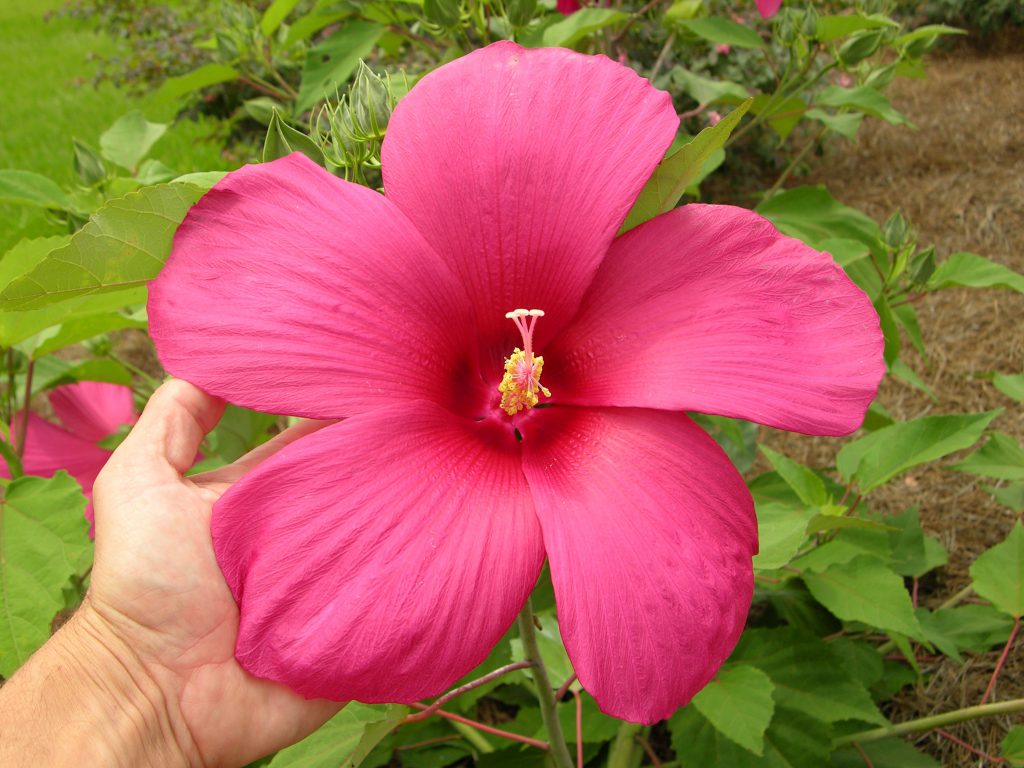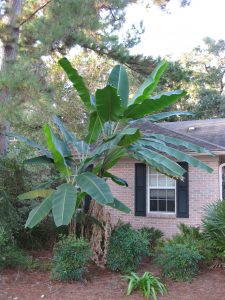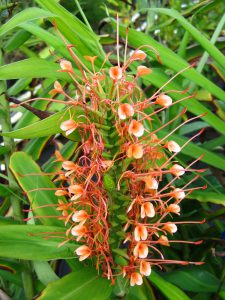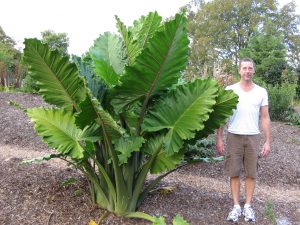The dog days of summer are here with high temperatures and humidity. While this sultry weather forces humans to retreat to air conditioning, our gardens suffer because the high night temperatures cause temperate plants to stop flowering, lose vigor and pause growth. By August, many plants in the garden look as bedraggled and wilted as we feel after mowing the grass or trying to weed.
All is not lost: the fading flowers and fizzling foliage of traditional garden plants can give way to heat-loving tropicals! Plants that are native to tropical and subtropical climates are naturally adapted to heat, humidity and rain, easily standing up to the worst that our north Florida summers can throw at them. Tropicals offer bright flowers, bold texture and exuberant growth just when the rest of your garden melts in the heat. Tropical plants include trees, shrubs, vines, perennials, groundcovers or annuals, and there are tropicals for full sun, part sun or shade.
Tropical Plants for North Florida
Top tropicals for north Florida gardens are palms, bananas, hibiscus, and gingers. Palms are the iconic symbol of the Tropics. Native subtropical palms can give you the palm vibe without the worry of cold hardiness. These include cabbage palm and related palmettos in the genus Sabal, paurotis palm (Acoelorrhaphe wrightii), saw palmetto (Serenoa repens) and needle palm (Rhapiophyllum hystrix). Non-native European fan (Chamaerops humilis), jelly (Butia spp.), windmill (Trachycarpus spp.), date (Phoenix spp.), Washington (Washingtonia spp.) and other palms also grow well and are cold hardy in north Florida. Most palms grow best in full to part sun but palmettos, saw palmetto and needle palm can handle more shade. Saw palmetto, needle palm and most palmettos grow 3 to 6 ft. tall. European fan, jelly, paurotis and windmill palms grow 10 to 20 ft. tall, while cabbage, Washington and date palms often exceed 40 ft. For best appearance, palms often require special fertilizer (https://edis.ifas.ufl.edu/ep261).
Characterized by their large, bold leaves, bananas are another plant group associated with tropical weather and full sun. Hardier forms of banana that thrive here include Chinese yellow (Musella lasiocarpa), pink (M. velutina), basjoo (Musa basjoo), Yunnan (M. itinerans), and hardy Yunnan (M. yunnanensis). Chinese yellow and pink bananas grow about 5 ft. or more in height, whereas the others have mature heights of 20 ft. or more. Bananas benefit from planting in a location that blocks strong winds so as not to shred the leaves. Depending on the severity of our winter, these bananas may lose some or all leaves but they usually regrow in late spring once warm weather arrives.
The large, colorful and exotic-looking flowers of tropical hibiscus (Hibiscus rosa-sinensis) are associated with the tropics, though this hibiscus is less cold hardy here and is perhaps best enjoyed as a container plant. Other notable hibiscus for north Florida include Confederate rose (H. mutabilis), rose-of-sharon or althea (H. syriacus), and hardy hibiscus (many hybrids of H. moscheutos and other native species). Varying in height from 3 (hardy hibiscus) to 12 ft. (confederate rose), hibiscus thrives in full sun and moist, even wet, soil. Their summer flowers come in colors of white, lavender, pink and red and range in size from a few inches (althea) to the size of dinnerplates (hardy hibiscus)! Except for rose-of-sharon, these hibiscus die back in winter and re-emerge again in late spring.
Gingers are also symbolic of the tropics. Many produce complex or colorful flowers and often flowers or other plant parts are aromatic. Ginger lily (Hedychium spp.), spiral ginger (Costus spp.) and shell ginger (Alpinia spp.) have fragrant and colorful racemes or spikes of flowers that appear at the tops of stems 4 ft. to 6 ft. or more tall. Hidden ginger (Curcuma spp.) and true ginger (Zingiber spp.) are lower growing with flowers appearing in “cones” on tops of separate, short stems. Finally, the patterned leaves of peacock ginger (Kaempferia spp.) make a beautiful summer groundcover. Gingers grow best in part sun to part shade.
There are many other tropical plants including coral tree (Erythrina × bidwillii and E. crista-galli), pride-of-barbados (Caesalpinia pulcherrima), fatsia (Fatsia japonica), selloum philodendron (Thaumatophyllum bipinnatifidum), canna lily (the non-invasive Canna × generalis hybrids), peregrina (Jatropha integerrima), elephant ear (non-invasive Alocasia spp. types), Begonia spp. (annual, angelwing and rhizomatous types) and Caladium selections. Bamboos have a tropical look, but many grow aggressively and may be invasive in north Florida. Two recommended clumping bamboos are common bamboo (Bambusa vulgaris; growing 15 ft or more tall) and Chinese garden bamboo (Drepanostachyum falcatum; growing 12 ft. or more tall).
“Tropical” does not necessarily mean “non-native” as there are many Florida natives that provide summer color or texture and are heat loving yet cold hardy in north Florida. These include some palms (cabbage, palmetto, paurotis), ashe magnolia (Magnolia ashei), switchcane (Arundinaria gigantea, a native bamboo), hardy hibiscus (Hibiscus grandiflorus, H. moscheutos and others), golden canna (Canna flaccida), and maypop passionflower (Passiflora incarnata).
Disadvantages of Tropicals
Use of tropicals in your garden does have a downside. Most tropicals are water hogs and need regular irrigation. This isn’t a problem if our area experiences the normal patterns of summer thunderstorms. However, if we don’t receive regular rainfall, tropical plants create the burden of having to water them regularly or else their flowers wilt and leaves droop.
Another disadvantage of tropicals is the “off-season” appearance. Though they thrive in summer heat, they grow slowly during the cooler temperatures of spring and fall and some disappear altogether in winter. Some tropicals are not winter hardy in north Florida and must be replanted each year or undergo elaborate cold protection strategies to help them survive. Other tropicals will over-winter, but often are burned back by frosts, requiring labor to cut back the dead foliage and stems. Finally, tropicals usually require warm weather for growth to resume, and tropicals that die back will produce gaps in your landscape during winter, spring and early summer.
At the other extreme, some tropicals have such exuberant growth that they are invasive in north Florida. For example, almost all running types of bamboo and many clumping bamboos are invasive, other than those mentioned previously. Also avoid non-native canna (Canna indica), elephant ears (Colocasia and Xanthosoma spp.), Lantana (sterile forms are OK), and some non-native passionvines (Passiflora spp.). If you have questions about a plant’s invasiveness, check the UF/IFAS Assessment of Non-Native Plants in Florida’s Natural Areas, https://assessment.ifas.ufl.edu/.
Using Tropicals in North Florida
Tropicals are best used as accent plants to draw attention in summer when they look their best and the rest of the garden looks its worst. When used as accents, place them throughout the landscape so that winter damage or absences aren’t noticed. Concentrations of tropicals in one area will look great in summer but could look like a mass of dead foliage in winter! To create an entirely tropical-looking planting in north Florida, combine tropical plants with cold-hardy tropical lookalikes (a topic for another time!).
Plant tropicals in late spring once temperatures warm because they will grow slowly or even experience damage at temperatures below 50°F. Best practices for tropicals are to place them in the appropriate exposure for the particular plant (sun, part sun or shade) and keep them mulched. One common characteristic of tropicals is their need for soil moisture, necessitating irrigation to supplement rain. A rich soil or applications of organic mulches or compost can provide nutrients for growth, or light fertilizer applications in summer can boost growth.
Tropicals come alive in the heat of summer. When used in north Florida gardens, tropical plants provide pops of color, luxuriant growth and big, bold, dramatic texture that rescue our gardens from the doldrums of summer!
- Foodscaping – Create Beauty and Bounty - April 7, 2022
- Cold-hardy Bromeliads for North Florida - December 15, 2021
- How to Hunt for “New” Plants - September 2, 2021





